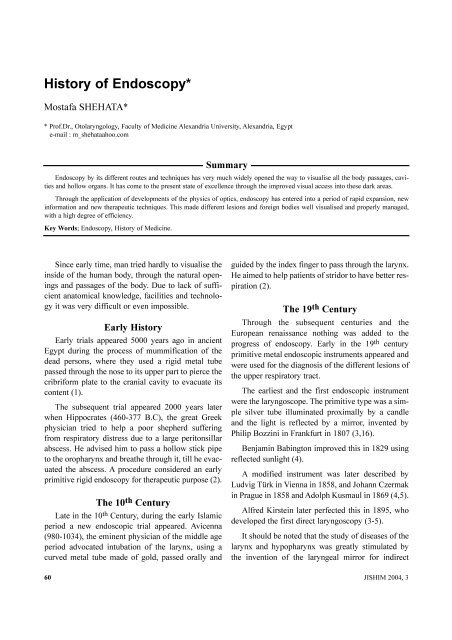Journal - International Society for the History of Islamic Medicine
Journal - International Society for the History of Islamic Medicine
Journal - International Society for the History of Islamic Medicine
Create successful ePaper yourself
Turn your PDF publications into a flip-book with our unique Google optimized e-Paper software.
<strong>History</strong> <strong>of</strong> Endoscopy*<br />
Mostafa SHEHATA*<br />
* Pr<strong>of</strong>.Dr., Otolaryngology, Faculty <strong>of</strong> <strong>Medicine</strong> Alexandria University, Alexandria, Egypt<br />
e-mail : m_shehataahoo.com<br />
Since early time, man tried hardly to visualise <strong>the</strong><br />
inside <strong>of</strong> <strong>the</strong> human body, through <strong>the</strong> natural openings<br />
and passages <strong>of</strong> <strong>the</strong> body. Due to lack <strong>of</strong> sufficient<br />
anatomical knowledge, facilities and technology<br />
it was very difficult or even impossible.<br />
Early <strong>History</strong><br />
Early trials appeared 5000 years ago in ancient<br />
Egypt during <strong>the</strong> process <strong>of</strong> mummification <strong>of</strong> <strong>the</strong><br />
dead persons, where <strong>the</strong>y used a rigid metal tube<br />
passed through <strong>the</strong> nose to its upper part to pierce <strong>the</strong><br />
cribri<strong>for</strong>m plate to <strong>the</strong> cranial cavity to evacuate its<br />
content (1).<br />
The subsequent trial appeared 2000 years later<br />
when Hippocrates (460-377 B.C), <strong>the</strong> great Greek<br />
physician tried to help a poor shepherd suffering<br />
from respiratory distress due to a large peritonsillar<br />
abscess. He advised him to pass a hollow stick pipe<br />
to <strong>the</strong> oropharynx and brea<strong>the</strong> through it, till he evacuated<br />
<strong>the</strong> abscess. A procedure considered an early<br />
primitive rigid endoscopy <strong>for</strong> <strong>the</strong>rapeutic purpose (2).<br />
The 10th Century<br />
Late in <strong>the</strong> 10th Century, during <strong>the</strong> early <strong>Islamic</strong><br />
period a new endoscopic trial appeared. Avicenna<br />
(980-1034), <strong>the</strong> eminent physician <strong>of</strong> <strong>the</strong> middle age<br />
period advocated intubation <strong>of</strong> <strong>the</strong> larynx, using a<br />
curved metal tube made <strong>of</strong> gold, passed orally and<br />
Summary<br />
Endoscopy by its different routes and techniques has very much widely opened <strong>the</strong> way to visualise all <strong>the</strong> body passages, cavities<br />
and hollow organs. It has come to <strong>the</strong> present state <strong>of</strong> excellence through <strong>the</strong> improved visual access into <strong>the</strong>se dark areas.<br />
Through <strong>the</strong> application <strong>of</strong> developments <strong>of</strong> <strong>the</strong> physics <strong>of</strong> optics, endoscopy has entered into a period <strong>of</strong> rapid expansion, new<br />
in<strong>for</strong>mation and new <strong>the</strong>rapeutic techniques. This made different lesions and <strong>for</strong>eign bodies well visualised and properly managed,<br />
with a high degree <strong>of</strong> efficiency.<br />
Key Words; Endoscopy, <strong>History</strong> <strong>of</strong> <strong>Medicine</strong>.<br />
guided by <strong>the</strong> index finger to pass through <strong>the</strong> larynx.<br />
He aimed to help patients <strong>of</strong> stridor to have better respiration<br />
(2).<br />
The 19th Century<br />
Through <strong>the</strong> subsequent centuries and <strong>the</strong><br />
European renaissance nothing was added to <strong>the</strong><br />
progress <strong>of</strong> endoscopy. Early in <strong>the</strong> 19th century<br />
primitive metal endoscopic instruments appeared and<br />
were used <strong>for</strong> <strong>the</strong> diagnosis <strong>of</strong> <strong>the</strong> different lesions <strong>of</strong><br />
<strong>the</strong> upper respiratory tract.<br />
The earliest and <strong>the</strong> first endoscopic instrument<br />
were <strong>the</strong> laryngoscope. The primitive type was a simple<br />
silver tube illuminated proximally by a candle<br />
and <strong>the</strong> light is reflected by a mirror, invented by<br />
Philip Bozzini in Frankfurt in 1807 (3,16).<br />
Benjamin Babington improved this in 1829 using<br />
reflected sunlight (4).<br />
A modified instrument was later described by<br />
Ludvig Türk in Vienna in 1858, and Johann Czermak<br />
in Prague in 1858 and Adolph Kusmaul in 1869 (4,5).<br />
Alfred Kirstein later perfected this in 1895, who<br />
developed <strong>the</strong> first direct laryngoscopy (3-5).<br />
It should be noted that <strong>the</strong> study <strong>of</strong> diseases <strong>of</strong> <strong>the</strong><br />
larynx and hypopharynx was greatly stimulated by<br />
<strong>the</strong> invention <strong>of</strong> <strong>the</strong> laryngeal mirror <strong>for</strong> indirect<br />
60 JISHIM 2004, 3

















